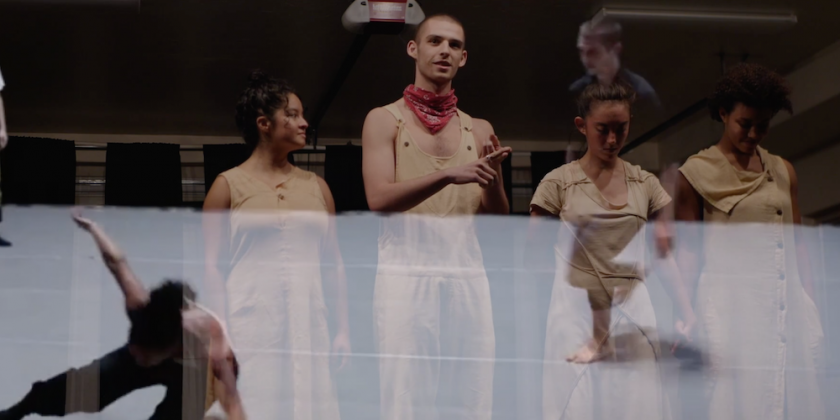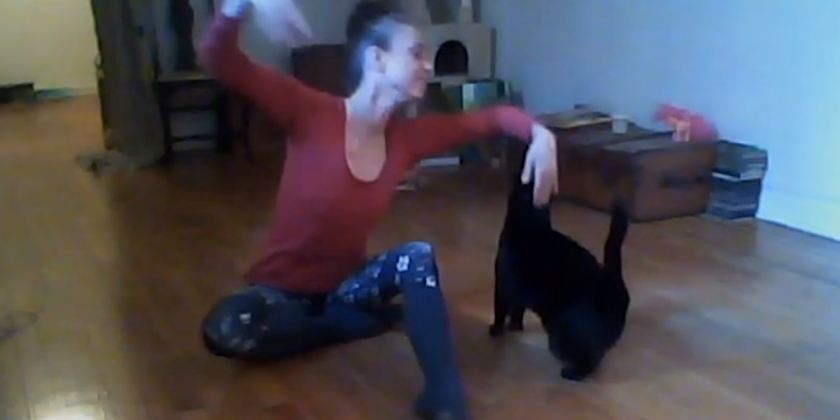IMPRESSIONS: Russell Dumas

Dance for the Time Being
Choreography: Russell Dumas
Dancers: Jonathon Sinatra, Stuart Shugg, Nicole Jenvey, Linda Sastradipradja, and Christine Babinskas
Location: Baryshnikov Arts Center’s Howard Gilman Performance Space 2pm on October 10, 2010
Hannah Krafcik 2010
Dancers: Jonathon Sinatra, Stuart Shugg, Nicole Jenvey, Linda Sastradipradja, and Christine Babinskas
Location: Baryshnikov Arts Center’s Howard Gilman Performance Space 2pm on October 10, 2010
Hannah Krafcik 2010
“This work is an attempt to make a community of the individuals who constitute both audience and participants: a temporary collective—a community for the time being.”
– Taken from the program notes describing Russell Dumas’ Dance for the Time Being
– Taken from the program notes describing Russell Dumas’ Dance for the Time Being
The first step in bridging the gap between audience members and artistic participants present within a given space is generally to strip said space of the theatrical tropes that divide those who watch from those who perform.

Dance for the Time Being, Russell Dumas at B.A.C - Photo by Julie Lemberger
|
Certainly, the Howard Gilman Performance Space lends itself to such an un-theatrical configuration. It does not contain a stage or any means of elevating audiences or performers. Rather, audience members present for this matinee performance of Russell Dumas’ Dance for the Time Being sat wrapped around two sides of the unadorned and naturally lit room, on level with the five dancers who were casually warming up in its center.
The dancers were dressed in faded black sweats, which typified their nonchalance and postmodern lack of formality. After they had finished their warm up, they exited the space, only to re-enter and begin their first vignette—a quintet of sparse and gestural movement. The entire work consisted of a series of these little vignettes performed by anywhere between one and five dancers. Dumas often paired the performers off, forcing the audience members to choose explicitly which duet or trio would hold their attention at a given moment.

Dance for the Time Being, Russell Dumas at B.A.C - Photo by Julie Lemberger
|
Indeed, the movement shared between a duet or trio demanded rapt attention—not because the choreography appeared exceptionally precarious, but because the dancers were so profoundly meek and focused as they met one another. “Dumas’ intricate exploration of how bodies might cantilever or be organized alongside one another was intriguing, to be sure. Yet, it was the dancer’s temperate and gentle manner of handling one another that gripped me, and, at these moments, I could simultaneously sense utter engagement of the audience surrounding me."
The dancers exerted their energy evenly, expending the same amount of effort in smallest gesture as in the most impressive cantilever. Their lifts, dips, and careful placement of hands and feet contained such graceful resignation that I found myself searching for those discrete moments of natural tension.

Dance for the Time Being, Russell Dumas at B.A.C - Photo by Julie Lemberger
|
Performed without accompaniment, every rustle of program notes, every pensive exhalation, echoed through the space. I heard the whispers of those behind me while I sought out the subtle vocalizations that the dancers occasionally let slip.
This ingenious performance operated as the catalyst for a collective consciousness: a communal empathy contingent on the vocalized, visualized, and internalized experience of those who share a leveled and unhampered space, if only “for the time being.”











